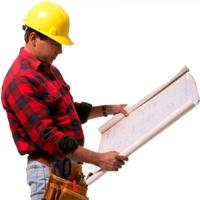Understanding the Soil Environment
by Dan Eskelson on May 3, 2012
A basic understanding of soils allows the gardener to work with natural processes to enhance plant root growth and overall vigor. Turfgrasses are as demanding of proper soil conditions as all plants - healthy soil grows healthy plants. Soil is an amazingly complex, living ecosystem requiring a balance of organic, inorganic, living, and nonliving components.
Recent soil science research has demonstrated that the most productive soils are loaded with a variety of microbial life; beneficial fungi, bacteria, yeasts, and other microorganisms work to decompose organic matter into humus. Humus directly influences both the assimilation of nutrients and plant resistance to disease, insects, drought, and other stresses.
Physically, the soil should be composed of fifty percent solids and twenty-five percent each liquid and air, with an organic matter content of three to five percent. On this side of Iowa, the "ideal" soil is seldom found in the native habitat. Here in the West, we are required to amend the soil to provide the optimal growth environment. The various fine-particle clays and silts of our region benefit greatly from the addition of organic matter.
Alkaline clays (high pH) should also be amended with gypsum. The addition of organic matter to sandy and gravelly soils is also beneficial, increasing water retention and providing essential nutrients. Initial expense for organic matter and other amendments pays for the continued beauty and health of the planting. New lawn installations should start with basic soil considerations; physical and chemical soil analyses may be desired.
Marginal soil conditions in existing lawns can be improved with cultural programs designed for the specific site. Regular aeration, vertical mowing, top dressing with compost or rich soil, proper fertility management, and applications of foliar and soil biostimulants are all proven techniques for rejuvenating a poor lawn. A properly balanced soil will support deep, extensive root systems, allowing plants to assimilate all available food and moisture. The result is a thick turf that resists drought, weeds, and disease.
For basic physical soil analysis, use a soil probe or large, strong knife to cut samples at least six inches deep. Examine for thatch layer thickness, particle size, distribution, compaction, and topsoil depth. A minimum of six inches of properly balanced soil is required to grow a healthy lawn. A thatch layer thicker than a one-half inch will act as a sponge to limit the penetration of water and nutrients to the root system. If necessary, consult with a qualified landscape professional for help with soil testing.
Basic chemical soil tests (nitrogen, phosphorus, potassium, and pH) can be handled through the county extension service. For a very thorough soil analysis with written interpretation and recommendations, contact Integrated Fertility Management at (800) 332-3179. What occurs below ground, unseen, largely determines what we see above ground. The knowledge of basic soil conditions is essential to proper cultural decisions and practices. Again, healthy soil grows healthy plants.
Preferred Organic Matter Amendments
- Commercial compost - bulk or bagged
- Well-aged manure - our favorite is a horse manure
- Blood, bone, and cottonseed meals
- Bagged products - steer manure, chicken compost, etc.
- Well rotted sawdust
- Grass clippings - with no herbicide residue!
- Chopped straw or hay.
- Decomposed pine needles (for acid-loving plants) and hardwood leaves(#'s 5-8 are best when first composted with manure, or worked into the soil well ahead of planting)
Popular Articles
Three Places to Spend Money on the Exterior of Your Home
When you have the exterior of your home remodeled, you are investing, time, energy and convenience into the project and you want to make sure that...
104868 Views
Homemade Headboards-Make an Upholstered or Wooden Headboard
Homemade headboards can add a lot of personality to any bedroom. They can be coordinated with existing furniture and room decor or they can be the...
80121 Views
When to Use a Brush, Roller or Sponge Brush
Brushes are a good choice for painting trim and woodwork. They are also useful for cutting in the edges around the top and bottom edges and corners...
72783 Views
Creating a Cottage Kitchen with Bead Board
Kitchen decor can range from modern and bold to elegant and elaborate by using strategic kitchen pieces. One of the most popular decorating trends...
58550 Views
Gas Fireplace Diagnostics and Troubleshooting
Follow these steps for diagnosing and troubleshooting Gas Fireplaces repairs. For the average DIYer, this may seem intimidating, depending on the...
35588 Views
Latest Articles
How Much Does it Cost to Take a Bath?
Plumbers know that a bath may seem like a relaxing luxury, but the real cost extends far beyond your water bill. The average soak uses 35 to 50...
on Apr 8, 2025
10 Concrete Patio Ideas on a Budget
A concrete patio can be a game-changer for your outdoor space. It is durable, versatile, and can be customized to fit your style. But what if you...
on Mar 25, 2025
Tips for Creating a Stunning Personalized Photo on Canvas
Order the unique beauty of a personalized photo on canvas and bring your memories to life. With a customized photo on canvas, you can transform...
on Mar 7, 2025
Best Areas to Buy Property in Singapore for Long-Term Growth
Singapore's real estate market remains one of the most stable and lucrative in the world. With limited land supply, strong governmental...
on Feb 18, 2025
Troubleshooting Excess Water in Your HVAC Secondary Condensate Drain Pan
When maintaining your air conditioning system, it is easy to overlook the condensate drain pan - until excess water starts pooling in places where...
on Jan 12, 2025
Featured Articles
What Type of Licensed Contractor Should You Hire?
on Feb 28, 2017
Hire Contractors / Estimates

Looking for a specialty project? There are many types of contractors available for your home improvement needs. Finding the right type of...
Sponsored Articles
Best Areas to Buy Property in Singapore for Long-Term Growth
on Feb 18, 2025
Real Estate / Finance

Singapore's real estate market remains one of the most stable and lucrative in the world. With limited land supply, strong governmental...
Actions
Top Categories
- Garden / Landscaping / Patio — 264
- Kitchen / Bathrooms — 240
- Real Estate / Finance — 203
- Appliance / Repair — 186
- Interior Design / Decor — 184
- HVAC / Air Conditioning — 148
- Cleaning / Maintenance — 144
- Improvements / Remodeling — 131
- Plumbing / Basements — 118
- Floors / Tile / Hardwood — 116
- Doors / Garages — 113
- Safety / Security — 113
Articles Archive
More DIY Articles
5 Creative Ways to Organise Your Office
We all know the struggle of having of messy office and an even messier desk. We just never seem to have the time to clean and organize everything...
Wallpaper Versus Paint: Which is the Better Choice for Your New Home?
If you are in the process of decorating your new home and learning how to properly make it your own, you will be faced with the choice of using...
How Large can I Build a Structure in my Backyard?
If you are really asking how big you can build without having to worry about permits and paperwork, that is a different issue than having an...
Exploring Outdoor Kitchens
What is an outdoor kitchen exactly? Did you know outdoor kitchens are the second most popular home remodeling project in America after the good old...
Basic Concepts: Line and Form for Landscaping
The form of structures should be considered for landscaping, as well as the relationship between this form and the form of adjacent plants. Forms...

